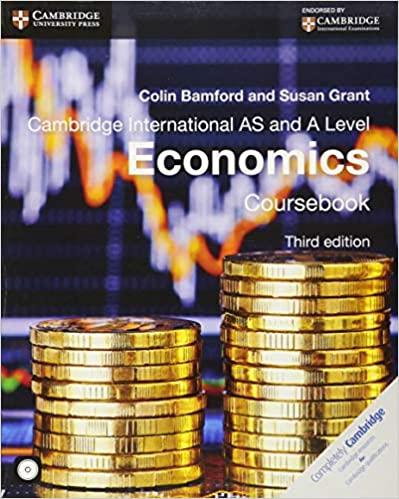Question
PLEASE GRAPH THIS PROBLEM! 2) In Leisure Luxuries and the Labor Supply of Young Men (2017), Aguiar, Bils, Charles, and Hurst argue that the decline
PLEASE GRAPH THIS PROBLEM!
2) In "Leisure Luxuries and the Labor Supply of Young Men" (2017), Aguiar, Bils, Charles, and Hurst argue that the decline in labor participation of men aged 21-30 is due to improvements in video games. The authors can attribute to half of the increase in leisure time among this group since 2004 to these improvements. Using our model from Chapter 2 and assuming some non-zero endowment, show (I want a graph) and explain the effect these improvements could have on the labor force participation decision of a hypothetical young man.
The consumption-leisure decision is a choice between consuming now or consuming later. The individual must decide how much to consume now and how much to save for later. The individual must also decide how much leisure to enjoy now and how much to work.The effect of improved video games on the labor force participation decision of a hypothetical young man would be to reduce the amount of work he does. This is because the improved video games would provide the young man with more leisure time.The authors of "Leisure Luxuries and the Labor Supply of Young Men" (2017) argue that the decline in labor participation of men aged 21-30 is due to improvements in video games. The authors can attribute to half of the increase in leisure time among this group since 2004 to these improvements.To show the effect of these improvements on the labor force participation decision of a hypothetical young man, I first need to consider his budget constraint. This dictates the maximum amount of consumption and leisure he can have, given his income and the prices of consumption and leisure. For example, if his income is $100 and the price of consumption is $10, then his budget constraint would be as follows:
C + L <= 100
10C + L <= 100
C <= 10
L <= 90
This means that the most he can consume is $10, and the most he can enjoy in terms of leisure is 90 minutes. From here, I need to consider his preferences to make his final decision. If he has a higher preference for consumption, then he will choose to consume more and have less leisure. Conversely, if he has a higher preference for leisure, then he will choose to consume less and have more leisure. If the young man's preferences have not changed, the only thing that has changed is the amount of leisure he can enjoy due to improvements in video games. This means that his budget constraint has shifted outwards, as he can now consume more and enjoy more leisure. His new budget constraint would be as follows:
C + L <= 110
10C + L <= 110
C <= 11
L <= 99
This means that the most he can consume is $11, and the most he can enjoy in terms of leisure is 99 minutes. Since his preferences have not changed, he will still choose to consume less in order to have more leisure. His new consumption-leisure decision would be as follows:
C = $5.50
L = 99.5 minutes
Step by Step Solution
There are 3 Steps involved in it
Step: 1

Get Instant Access to Expert-Tailored Solutions
See step-by-step solutions with expert insights and AI powered tools for academic success
Step: 2

Step: 3

Ace Your Homework with AI
Get the answers you need in no time with our AI-driven, step-by-step assistance
Get Started


